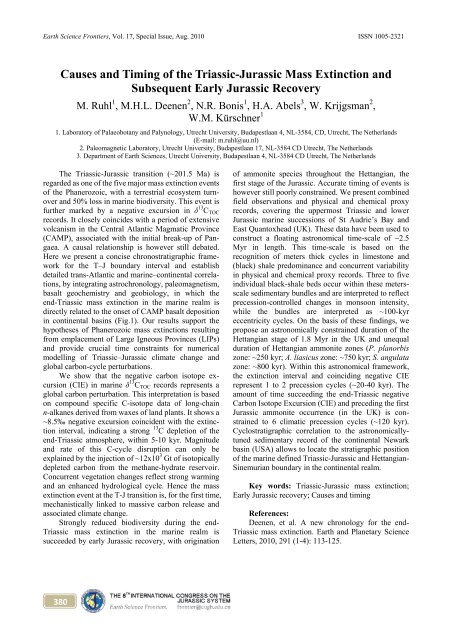in Jurassic and Cretaceous Stratigraphy
in Jurassic and Cretaceous Stratigraphy
in Jurassic and Cretaceous Stratigraphy
Create successful ePaper yourself
Turn your PDF publications into a flip-book with our unique Google optimized e-Paper software.
Earth Science Frontiers, Vol. 17, Special Issue, Aug. 2010 ISSN 1005-2321<br />
Causes <strong>and</strong> Tim<strong>in</strong>g of the Triassic-<strong>Jurassic</strong> Mass Ext<strong>in</strong>ction <strong>and</strong><br />
Subsequent Early <strong>Jurassic</strong> Recovery<br />
380<br />
M. Ruhl 1 , M.H.L. Deenen 2 , N.R. Bonis 1 , H.A. Abels 3 , W. Krijgsman 2 ,<br />
W.M. Kürschner 1<br />
1. Laboratory of Palaeobotany <strong>and</strong> Palynology, Utrecht University, Budapestlaan 4, NL-3584, CD, Utrecht, The Netherl<strong>and</strong>s<br />
(E-mail: m.ruhl@uu.nl)<br />
2. Paleomagnetic Laboratory, Utrecht University, Budapestlaan 17, NL-3584 CD Utrecht, The Netherl<strong>and</strong>s<br />
3. Department of Earth Sciences, Utrecht University, Budapestlaan 4, NL-3584 CD Utrecht, The Netherl<strong>and</strong>s<br />
The Triassic-<strong>Jurassic</strong> transition (~201.5 Ma) is<br />
regarded as one of the five major mass ext<strong>in</strong>ction events<br />
of the Phanerozoic, with a terrestrial ecosystem turn-<br />
over <strong>and</strong> 50% loss <strong>in</strong> mar<strong>in</strong>e biodiversity. This event is<br />
further marked by a negative excursion <strong>in</strong> δ 13 CTOC<br />
records. It closely co<strong>in</strong>cides with a period of extensive<br />
volcanism <strong>in</strong> the Central Atlantic Magmatic Prov<strong>in</strong>ce<br />
(CAMP), associated with the <strong>in</strong>itial break-up of Pan-<br />
gaea. A causal relationship is however still debated.<br />
Here we present a concise chronostratigraphic frame-<br />
work for the T–J boundary <strong>in</strong>terval <strong>and</strong> establish<br />
detailed trans-Atlantic <strong>and</strong> mar<strong>in</strong>e–cont<strong>in</strong>ental correla-<br />
tions, by <strong>in</strong>tegrat<strong>in</strong>g astrochronology, paleomagnetism,<br />
basalt geochemistry <strong>and</strong> geobiology, <strong>in</strong> which the<br />
end-Triassic mass ext<strong>in</strong>ction <strong>in</strong> the mar<strong>in</strong>e realm is<br />
directly related to the onset of CAMP basalt deposition<br />
<strong>in</strong> cont<strong>in</strong>ental bas<strong>in</strong>s (Fig.1). Our results support the<br />
hypotheses of Phanerozoic mass ext<strong>in</strong>ctions result<strong>in</strong>g<br />
from emplacement of Large Igneous Prov<strong>in</strong>ces (LIPs)<br />
<strong>and</strong> provide crucial time constra<strong>in</strong>ts for numerical<br />
modell<strong>in</strong>g of Triassic–<strong>Jurassic</strong> climate change <strong>and</strong><br />
global carbon-cycle perturbations.<br />
We show that the negative carbon isotope ex-<br />
cursion (CIE) <strong>in</strong> mar<strong>in</strong>e δ 13 CTOC records represents a<br />
global carbon perturbation. This <strong>in</strong>terpretation is based<br />
on compound specific C-isotope data of long-cha<strong>in</strong><br />
n-alkanes derived from waxes of l<strong>and</strong> plants. It shows a<br />
~8.5‰ negative excursion co<strong>in</strong>cident with the ext<strong>in</strong>c-<br />
tion <strong>in</strong>terval, <strong>in</strong>dicat<strong>in</strong>g a strong 13 C depletion of the<br />
end-Triassic atmosphere, with<strong>in</strong> 5-10 kyr. Magnitude<br />
<strong>and</strong> rate of this C-cycle disruption can only be<br />
expla<strong>in</strong>ed by the <strong>in</strong>jection of ~12x10 3 Gt of isotopically<br />
depleted carbon from the methane-hydrate reservoir.<br />
Concurrent vegetation changes reflect strong warm<strong>in</strong>g<br />
<strong>and</strong> an enhanced hydrological cycle. Hence the mass<br />
ext<strong>in</strong>ction event at the T-J transition is, for the first time,<br />
mechanistically l<strong>in</strong>ked to massive carbon release <strong>and</strong><br />
associated climate change.<br />
Strongly reduced biodiversity dur<strong>in</strong>g the end-<br />
Triassic mass ext<strong>in</strong>ction <strong>in</strong> the mar<strong>in</strong>e realm is<br />
succeeded by early <strong>Jurassic</strong> recovery, with orig<strong>in</strong>ation<br />
of ammonite species throughout the Hettangian, the<br />
first stage of the <strong>Jurassic</strong>. Accurate tim<strong>in</strong>g of events is<br />
however still poorly constra<strong>in</strong>ed. We present comb<strong>in</strong>ed<br />
field observations <strong>and</strong> physical <strong>and</strong> chemical proxy<br />
records, cover<strong>in</strong>g the uppermost Triassic <strong>and</strong> lower<br />
<strong>Jurassic</strong> mar<strong>in</strong>e successions of St Audrie’s Bay <strong>and</strong><br />
East Quantoxhead (UK). These data have been used to<br />
construct a float<strong>in</strong>g astronomical time-scale of ~2.5<br />
Myr <strong>in</strong> length. This time-scale is based on the<br />
recognition of meters thick cycles <strong>in</strong> limestone <strong>and</strong><br />
(black) shale predom<strong>in</strong>ance <strong>and</strong> concurrent variability<br />
<strong>in</strong> physical <strong>and</strong> chemical proxy records. Three to five<br />
<strong>in</strong>dividual black-shale beds occur with<strong>in</strong> these meters-<br />
scale sedimentary bundles <strong>and</strong> are <strong>in</strong>terpreted to reflect<br />
precession-controlled changes <strong>in</strong> monsoon <strong>in</strong>tensity,<br />
while the bundles are <strong>in</strong>terpreted as ~100-kyr<br />
eccentricity cycles. On the basis of these f<strong>in</strong>d<strong>in</strong>gs, we<br />
propose an astronomically constra<strong>in</strong>ed duration of the<br />
Hettangian stage of 1.8 Myr <strong>in</strong> the UK <strong>and</strong> unequal<br />
duration of Hettangian ammonite zones (P. planorbis<br />
zone: ~250 kyr; A. liasicus zone: ~750 kyr; S. angulata<br />
zone: ~800 kyr). With<strong>in</strong> this astronomical framework,<br />
the ext<strong>in</strong>ction <strong>in</strong>terval <strong>and</strong> co<strong>in</strong>cid<strong>in</strong>g negative CIE<br />
represent 1 to 2 precession cycles (~20-40 kyr). The<br />
amount of time succeed<strong>in</strong>g the end-Triassic negative<br />
Carbon Isotope Excursion (CIE) <strong>and</strong> preced<strong>in</strong>g the first<br />
<strong>Jurassic</strong> ammonite occurrence (<strong>in</strong> the UK) is con-<br />
stra<strong>in</strong>ed to 6 climatic precession cycles (~120 kyr).<br />
Cyclostratigraphic correlation to the astronomically-<br />
tuned sedimentary record of the cont<strong>in</strong>ental Newark<br />
bas<strong>in</strong> (USA) allows to locate the stratigraphic position<br />
of the mar<strong>in</strong>e def<strong>in</strong>ed Triassic-<strong>Jurassic</strong> <strong>and</strong> Hettangian-<br />
S<strong>in</strong>emurian boundary <strong>in</strong> the cont<strong>in</strong>ental realm.<br />
Key words: Triassic-<strong>Jurassic</strong> mass ext<strong>in</strong>ction;<br />
Early <strong>Jurassic</strong> recovery; Causes <strong>and</strong> tim<strong>in</strong>g<br />
References:<br />
Deenen, et al. A new chronology for the end-<br />
Triassic mass ext<strong>in</strong>ction. Earth <strong>and</strong> Planetary Science<br />
Letters, 2010, 291 (1-4): 113-125.

















